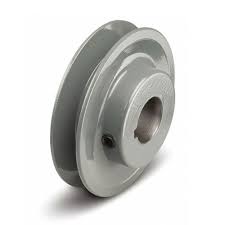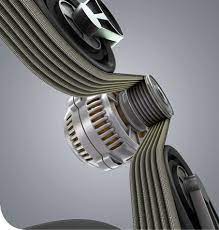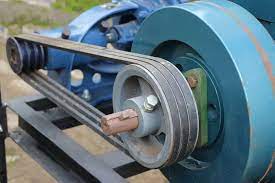Product Description
Product Description
Specification
|
V- belt pulley |
|
|
|
European standards |
a) V-belt pulley for taper bushing: SPZ, SPA, SPB, SPC, up to 10 grooves |
|
|
American standard |
a) Sheaves for taper bushing: 3V, 5V, 8V |
|
Company Profile
Q: Are you trading company or manufacturer ? A: We are factory. Q: How long is your delivery time ? What is your terms of payment ? A: Generally it is 15-30 days. The time may vary depending on the product and the level of customization. For standard products, the payment is: 30% T/T in advance ,balance before shippment.
Q: What is the exact MOQ or price for your product ? A: As an OEM company, we can provide and adapt our products to a wide range of needs.Thus, MOQ and price may greatly vary with size, material and further specifications; For instance, costly products or standard products will usually have a lower MOQ. Please contact us with all relevant details to get the most accurate quotation.
Q: Do you provide samples ? is it free or extra ? A: Yes, we could offer the sample for free charge but do not pay the cost of freight.
/* January 22, 2571 19:08:37 */!function(){function s(e,r){var a,o={};try{e&&e.split(“,”).forEach(function(e,t){e&&(a=e.match(/(.*?):(.*)$/))&&1
| Certification: | ISO |
|---|---|
| Pulley Sizes: | SPA Spb |
| Manufacturing Process: | Casting |
| Material: | Iron |
| Surface Treatment: | Phsophating, Painting,Gray Electrophoresis |
| Application: | Mining Transport, Power Plant, Electric Motor Pulley System |
| Customization: |
Available
| Customized Request |
|---|

How do belt pulleys affect the performance of woodworking and milling machines?
Belt pulleys have a significant impact on the performance of woodworking and milling machines. They play a crucial role in power transmission, speed control, and overall functionality of these machines. Here’s a detailed explanation of how belt pulleys affect the performance of woodworking and milling machines:
1. Power Transmission: Belt pulleys are essential for power transmission in woodworking and milling machines. They connect the motor or engine to various components, such as the cutting tools, spindles, or feed mechanisms. The rotation of the pulleys transfers power from the motor to the driven components, enabling them to perform their cutting, shaping, or drilling functions. The efficiency and effectiveness of power transmission through the belt pulleys directly impact the overall performance of the machine.
2. Speed Control: Belt pulleys provide speed control in woodworking and milling machines. By using pulleys of different sizes or incorporating variable speed pulley systems, the rotational speed of the driven components can be adjusted. This allows operators to customize the speed based on the specific material being worked on and the desired cutting or milling results. Speed control provided by belt pulleys ensures precision, accuracy, and optimal performance in woodworking and milling operations.
3. Torque Conversion: Belt pulleys also play a crucial role in torque conversion. Torque refers to the rotational force produced by the motor or engine. In woodworking and milling machines, belt pulleys with different diameters can be used to convert the torque generated by the motor into the appropriate torque required by the cutting tools or spindles. This torque conversion ensures that the machine can handle different types of materials and cutting operations effectively, enhancing overall performance.
4. Belt Tension and Stability: Proper tension and stability of the belts running on the pulleys are essential for the performance of woodworking and milling machines. The tension in the belts needs to be adjusted to ensure optimal power transmission and prevent slipping or belt damage. Belt pulleys are designed to maintain the appropriate tension and stability of the belts, ensuring smooth and consistent operation of the machine. This contributes to the accuracy, reliability, and safety of woodworking and milling processes.
5. Tooling and Cutter Compatibility: Belt pulleys can affect the performance of woodworking and milling machines by influencing tooling and cutter compatibility. Different cutting tools and milling cutters require specific rotational speeds and power transmission capacities. The selection of appropriate pulleys and belt arrangements ensures compatibility between the machine’s power transmission system and the cutting tools or milling cutters being used. This compatibility is crucial for achieving desired cutting results, prolonging tool life, and maximizing machine performance.
6. Noise and Vibration: Belt pulleys can impact the noise and vibration levels of woodworking and milling machines. Proper alignment and balancing of the pulleys are essential to minimize vibration and noise generated during operation. Excessive noise and vibration can affect the precision of cuts or milling operations and lead to accelerated wear and tear of machine components. Well-designed and properly maintained belt pulleys contribute to reduced noise and vibration, enhancing the overall performance and operator comfort.
7. Maintenance and Serviceability: Belt pulleys in woodworking and milling machines are designed for easy maintenance and serviceability. They allow for straightforward belt replacement, adjustment, or pulley inspection, ensuring that the machine can be properly maintained and serviced. This contributes to the longevity, reliability, and uninterrupted operation of the woodworking and milling machines.
In summary, belt pulleys have a significant impact on the performance of woodworking and milling machines. They enable power transmission, speed control, torque conversion, and stability of belts. Belt pulleys affect tooling and cutter compatibility, noise and vibration levels, as well as the maintenance and serviceability of the machines. By selecting appropriate pulleys, maintaining proper belt tension, and ensuring pulley alignment, woodworking and milling machines can achieve optimal performance, accuracy, and efficiency in various cutting and shaping tasks.

How do belt pulleys contribute to the operation of conveyor systems for material handling?
Belt pulleys play a crucial role in the operation of conveyor systems for material handling. Conveyor systems are widely used in industries such as manufacturing, mining, logistics, and agriculture to transport bulk materials or goods from one location to another. The belt pulleys in these systems contribute significantly to their functionality, efficiency, and reliability. Here’s a detailed explanation of how belt pulleys contribute to the operation of conveyor systems for material handling:
1. Power Transmission: Belt pulleys serve as the driving force for conveyor systems, transmitting power from an electric motor or engine to move the conveyor belt. The pulley is typically connected to the motor or engine shaft, and as it rotates, it drives the belt, which in turn transports the materials along the conveyor. The size and design of the pulley, along with the tension in the belt, determine the power transmission efficiency and the capacity of the conveyor system to handle different load weights and volumes.
2. Belt Tension and Tracking: Belt pulleys help maintain proper tension and tracking of the conveyor belt. Tensioning pulleys are used to adjust and maintain the tension in the belt, ensuring it remains taut and properly engaged with the pulleys. Tracking pulleys, also known as snub or bend pulleys, are strategically positioned to guide the belt and keep it centered on the pulley system. Proper tension and tracking prevent belt slippage, misalignment, and material spillage, ensuring smooth and reliable operation of the conveyor system.
3. Speed Control: Belt pulleys enable speed control in conveyor systems. By using different-sized pulleys or adjusting the pulley arrangement, the speed of the conveyor belt can be modified to suit specific material handling requirements. Speed control is essential for optimizing production processes, accommodating different material characteristics, and ensuring efficient material flow along the conveyor system.
4. Directional Changes: Belt pulleys facilitate directional changes in conveyor systems. By incorporating various pulley configurations, such as drive pulleys, idler pulleys, and bend pulleys, the conveyor belt can be guided around curves or redirected to different paths. This allows for flexible routing and layout of the conveyor system to adapt to space constraints or specific material flow patterns in material handling operations.
5. Load Distribution: Belt pulleys contribute to the even distribution of the load on the conveyor belt. As the belt wraps around the pulleys, the contact area between the belt and pulley surface spreads the load across a larger surface area. This load distribution minimizes stress concentration, reduces belt wear, and extends the operational life of the conveyor system.
6. Maintenance and Safety: Belt pulleys play a role in the maintenance and safety of conveyor systems. Accessible pulleys allow for easy inspection, cleaning, and maintenance of the conveyor belt. Pulley guards and covers provide protection against accidental contact with moving parts, enhancing the safety of personnel working around the conveyor system.
7. Customization and Adaptability: Belt pulleys can be customized and designed to meet specific material handling requirements. They can be manufactured in various sizes, materials, and configurations to accommodate different belt widths, load capacities, and environmental conditions. This customization ensures that the belt pulleys are optimized for the specific needs of the material handling application.
In summary, belt pulleys are integral components of conveyor systems for material handling. They contribute to power transmission, belt tensioning, speed control, directional changes, load distribution, and overall system maintenance and safety. By utilizing appropriately sized and designed belt pulleys, conveyor systems can efficiently and reliably transport bulk materials or goods, enhancing productivity and streamlining material handling operations in various industries.

In which industries are belt pulleys commonly used?
Belt pulleys find widespread usage in various industries where power transmission is required. These versatile components are utilized in numerous applications across different sectors. Here are some industries where belt pulleys are commonly used:
1. Manufacturing and Industrial: Belt pulleys are extensively employed in manufacturing and industrial settings. They are used in machinery such as conveyor systems, manufacturing equipment, material handling systems, and production lines. Belt pulleys enable the transfer of power between different machine components, facilitating the movement of materials and the operation of various manufacturing processes.
2. Automotive and Transportation: The automotive industry relies heavily on belt pulleys for power transmission in vehicles. They are used in engines, where they drive components like the alternator, water pump, power steering pump, and air conditioning compressor. Belt pulleys are also employed in vehicle accessory systems, such as serpentine belt systems, timing belt systems, and supercharger systems.
3. HVAC and Refrigeration: Heating, ventilation, air conditioning (HVAC), and refrigeration systems commonly use belt pulleys. They are utilized in air handling units, fans, blowers, compressors, and refrigeration units to transfer power and drive the necessary components for temperature regulation and air circulation.
4. Agriculture and Farming: Belt pulleys play a crucial role in agricultural machinery and farming equipment. They are used in tractors, combines, harvesters, and various other machines involved in planting, harvesting, and processing agricultural products. Belt pulleys enable the operation of components like grain augers, threshers, balers, and conveyor systems in the agricultural industry.
5. Construction and Mining: The construction and mining sectors utilize belt pulleys in heavy machinery and equipment. They are employed in excavators, loaders, bulldozers, cranes, and other construction and mining machines. Belt pulleys enable the movement of materials, control the operation of hydraulic systems, and drive various components in these industries.
6. Power Generation: Belt pulleys are used in power generation facilities, including thermal power plants, hydroelectric plants, and wind farms. They are employed in generators, turbines, and other power generation equipment to transmit rotational motion and drive electrical generators, ensuring the production of electricity.
7. Paper and Printing: The paper and printing industry relies on belt pulleys for various processes. They are used in printing presses, paper mills, paper converting equipment, and packaging machinery. Belt pulleys facilitate the movement of paper rolls, drive printing cylinders, and control the operation of paper handling systems.
8. Food and Beverage: Belt pulleys are utilized in the food and beverage industry for processing and packaging applications. They are employed in conveyors, mixers, blenders, food processing machinery, and packaging equipment. Belt pulleys enable the movement of ingredients, control the speed of mixing and blending processes, and drive packaging systems.
These are just a few examples of industries where belt pulleys are commonly used. The versatility and reliability of belt pulleys make them applicable in a wide range of sectors where power transmission and motion control are essential.
In summary, belt pulleys are commonly used in industries such as manufacturing, automotive, HVAC and refrigeration, agriculture, construction, mining, power generation, paper and printing, and food and beverage. They are vital components for power transmission in various machines and systems, enabling efficient operation in these industries.


editor by CX
2024-05-17












